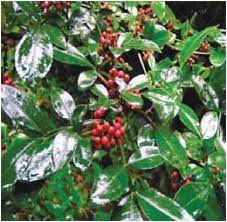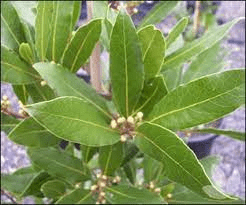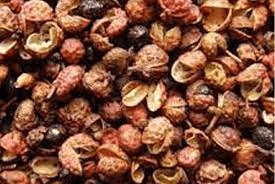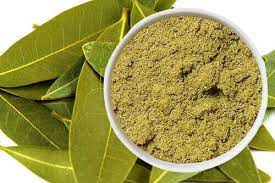Zanthoxylum armatum, commonly known as Tejpat or Indian Bay Leaf, is a deciduous aromatic shrub belonging to the Rutaceae family. This plant is native to the Indian subcontinent and is particularly prevalent in the Himalayan region.
Tejpat is valued for its aromatic leaves, which are commonly used as a spice in various cuisines, particularly in Indian, Nepali, and Bhutanese cooking. The leaves are elliptical, glossy, and emit a distinct fragrance when crushed. They are often used whole or ground to enhance the flavor of soups, stews, and rice dishes.
In addition to its culinary uses, Tejpat has a history of traditional medicinal applications. The plant contains bioactive compounds, including essential oils and alkaloids, contributing to its therapeutic properties.
It has been used in traditional medicine for its digestive, carminative, and anti-flatulent effects. Tejpat is also known for its potential antimicrobial and anti-inflammatory properties.
The essential oil extracted from Tejpat leaves is rich in chemical constituents such as cineole, sabinene, and linalool, contributing to its aromatic and medicinal qualities. The oil is sometimes used in aromatherapy for its calming and stress-relieving properties.
In horticulture, Zanthoxylum armatum is cultivated for both its culinary and medicinal uses. The plant is well-adapted to various climatic conditions and is known for its hardy nature.
Zanthoxylum armatum, or Tejpat, is a versatile plant with culinary and medicinal significance. Its aromatic leaves are a staple in various cuisines, and ongoing research continues to explore its potential health benefits.
Additionally, the plant is appreciated for its adaptability, making it a valuable resource in horticulture.
The Botanical Description of Zanthoxylum armatum
1. Leaves: Zanthoxylum armatum, commonly known as winged prickly ash or ‘Tejpat,’ exhibits pinnately compound leaves with serrated edges. The leaflets are lanceolate, creating a distinctive appearance.
2. Flowers: The plant produces small, yellowish-green flowers in clusters, contributing to its overall aesthetic appeal. These flowers play a crucial role in the reproductive cycle of Zanthoxylum armatum.
3. Fruits: Zanthoxylum armatum bears small, round fruits known as drupes. These drupes, often red when ripe, encase seeds and are a characteristic feature of the plant.
4. Bark: The bark of Zanthoxylum armatum is noteworthy for its prickly nature, housing thorn-like protrusions. It adds to the plant’s defenses and is utilized in various traditional practices.
5. Height and Growth Pattern: This deciduous shrub or small tree typically reaches a height of 3 to 5 meters. The growth pattern is branching, creating a bushy and dense appearance.
6. Aromatic Qualities: Zanthoxylum armatum is known for its aromatic properties. The leaves and bark emit a distinct fragrance, contributing to its culinary and medicinal applications.
7. Root System: The plant develops a well-established root system, providing stability and aiding in nutrient absorption from the soil.
8. Thorns: Thorn-like structures are present along the branches and bark, offering protection against herbivores and adding to the plant’s overall resilience.
9. Seasonal Changes: Zanthoxylum armatum undergoes seasonal changes, shedding leaves in the autumn and regenerating them in the spring, following a typical deciduous pattern.
10. Adaptability: Zanthoxylum armatum demonstrates adaptability to various soil types and climatic conditions, making it a hardy and versatile plant in different environments.
The Geographic Distribution of Zanthoxylum armatum

1. Native Regions: Zanthoxylum armatum is native to the Himalayan region, including countries like India, Nepal, Bhutan, and parts of China. It thrives in the diverse ecosystems of these mountainous areas.
2. Altitudinal Range: The plant exhibits a wide altitudinal distribution, ranging from lower elevations to higher mountain regions. It can be found at altitudes ranging from 200 to 2500 meters above sea level.
3. Sub-Himalayan Regions: Zanthoxylum armatum is commonly found in the sub-Himalayan regions, where it forms a part of the vegetation in both forested and open areas.
4. Cultivation in Other Regions: Due to its popularity, Zanthoxylum armatum has been cultivated beyond its native range. It can be found in botanical gardens and as an ornamental plant in various countries.
5. Soil Preferences: The plant shows a preference for well-draining soils and can adapt to a variety of soil types, including sandy, loamy, and clayey soils.
6. Climate Dependence: Zanthoxylum armatum thrives in temperate to subtropical climates. It is well-suited to areas with distinct seasons, experiencing cold winters and warm summers.
7. Human Impact: Human cultivation and utilization have contributed to the wider geographic distribution of Zanthoxylum armatum. It is often grown for its culinary and medicinal properties.
8. Biodiversity Contribution: In its native regions, Zanthoxylum armatum contributes to biodiversity by providing habitat and sustenance for various wildlife species.
9. Ecological Interactions: The plant engages in ecological interactions, with its aromatic qualities possibly playing a role in attracting pollinators and deterring herbivores.
10. Global Culinary Influence: Zanthoxylum armatum has influenced culinary traditions beyond its native regions. The unique flavor of its berries is utilized in diverse cuisines.
11. Invasive Potential: In some non-native regions, Zanthoxylum armatum has demonstrated invasive potential, impacting local ecosystems. Proper management is essential to mitigate potential ecological disruptions.
12. Conservation Status: The conservation status of Zanthoxylum armatum varies across regions. Efforts are underway to ensure sustainable harvesting and cultivation to prevent overexploitation in the wild.
The Chemical Composition of Zanthoxylum armatum
1. Alkaloids: Zanthoxylum armatum contains alkaloids, including berberine and magnoflorine, which contribute to its medicinal properties.
2. Essential Oils: The plant produces essential oils rich in compounds like limonene and pinene, adding to its aromatic qualities.
3. Flavonoids: Flavonoids, such as quercetin and kaempferol, are present in Zanthoxylum armatum, contributing to its antioxidant properties.
4. Lignans: Certain lignans, including fargesin, are found in the bark of Zanthoxylum armatum, which may have therapeutic effects.
5. Tannins: Tannins, known for their astringent properties, are present in various parts of the plant, including the bark and leaves.
6. Coumarins: Coumarins, such as scopoletin, are part of the chemical composition, offering potential pharmacological benefits.
7. Terpenoids: Zanthoxylum armatum contains terpenoids, including beta-caryophyllene, contributing to its diverse chemical profile.
8. Phenolic Compounds: Phenolic compounds, like gallic acid, are present and may contribute to the plant’s antioxidant and anti-inflammatory effects.
9. Resins: Resins found in Zanthoxylum armatum may have protective functions against pests and pathogens.
10. Sugars and Polyols: The plant contains sugars and polyols, adding to its nutritional content and potential sweetening properties.
11. Carotenoids: Carotenoids, such as beta-carotene, contribute to the vibrant color of the fruits and may have antioxidant effects.
12. Proteins: While present in smaller quantities, proteins are part of the chemical makeup, contributing to the overall nutritional content.
13. Steroids: Some varieties of Zanthoxylum armatum contain steroids, adding to the complexity of its chemical composition.
14. Vitamins: Zanthoxylum armatum incorporates vitamins, including vitamin C, enhancing its nutritional profile.
15. Minerals: Essential minerals like potassium and calcium are present, contributing to the overall health benefits of the plant.
Read Also: 8 Medicinal Health Benefits of Populus Grandidentata (Bigtooth Aspen)
The Medicinal Health Benefits Of Zanthoxylum armatum (Tejpat)

1. Gastrointestinal Health: Zanthoxylum armatum is known for its positive impact on gastrointestinal health. Compounds like berberine and tannins may aid digestion and alleviate common digestive issues.
2. Anti-Inflammatory Properties: The plant exhibits anti-inflammatory effects, potentially beneficial for conditions involving inflammation, such as arthritis or inflammatory bowel diseases.
3. Antioxidant Effects: The rich content of flavonoids and phenolic compounds contributes to the antioxidant effects of Zanthoxylum armatum, helping combat oxidative stress in the body.
4. Respiratory Support: Compounds found in Zanthoxylum armatum may offer respiratory support, making it valuable for conditions like coughs and respiratory infections.
5. Analgesic Action: Traditional uses of Zanthoxylum armatum include its analgesic properties, providing relief from pain and discomfort.
6. Cardiovascular Health: Certain components in the plant may contribute to cardiovascular health, with potential benefits for heart health and blood circulation.
7. Anti-Microbial Effects: Zanthoxylum armatum has demonstrated antimicrobial properties, making it valuable for combating certain infections.
8. Diuretic Properties: The plant may act as a diuretic, promoting the elimination of excess fluids from the body and supporting kidney function.
9. Skin Health: External applications of Zanthoxylum armatum may contribute to skin health, with potential benefits for conditions like dermatitis and eczema.
10. Immune System Support: The immunomodulatory effects of Zanthoxylum armatum may support and strengthen the immune system, helping the body defend against infections.
11. Neuroprotective Potential: Scientific studies suggest that compounds in Zanthoxylum armatum may have neuroprotective effects, potentially benefiting brain health.
12. Traditional Fever Remedy: In traditional medicine, Zanthoxylum armatum has been used as a remedy for fever, with its antipyretic properties helping reduce body temperature.
13. Anti-Diabetic Effects: Preliminary research indicates that the plant may have anti-diabetic effects, potentially influencing blood sugar regulation.
14. Anti-Cancer Properties: Ongoing studies explore the potential anti-cancer properties of Zanthoxylum armatum, emphasizing the need for further research in this area.
15. Liver Support: Traditional uses include the plant’s potential in supporting liver health, with its compounds possibly aiding in detoxification processes.
16. Stress Reduction: The aromatic qualities of Zanthoxylum armatum may contribute to stress reduction and relaxation, making it a valuable herb for overall well-being.
17. Anti-Arthritic Properties: Traditional uses include the plant’s potential in alleviating symptoms of arthritis, possibly due to its anti-inflammatory effects.
18. Wound Healing: External applications of Zanthoxylum armatum may promote wound healing, with its antimicrobial and anti-inflammatory effects contributing to the process.
The Methods of Usage to Achieve the Provided Health Benefits Of Zanthoxylum armatum (Tejpat)
1. Culinary Use: Zanthoxylum armatum is commonly used in culinary applications. The dried leaves, known as Tejpat, add a unique flavor to dishes, especially in Indian and Nepali cuisines.
2. Herbal Infusions: Infusions made from the leaves of Zanthoxylum armatum can be consumed as herbal teas, providing a convenient way to harness its health benefits.
3. Tinctures: Extracts of Zanthoxylum armatum can be prepared in alcohol or other solvents to create tinctures for controlled and precise dosage.
4. Topical Applications: Creams or balms containing extracts of Zanthoxylum armatum can be applied topically to address skin conditions or provide localized relief.
5. Inhalation Therapy: Inhaling the aroma of Zanthoxylum armatum, either through essential oils or as part of aromatherapy, may offer respiratory and stress-relieving benefits.
6. Capsules or Supplements: Zanthoxylum armatum extracts are available in capsule or supplement form, providing a convenient way to incorporate its health benefits into a daily routine.
7. Traditional Medicine Practices: In traditional medicine, practitioners may use specific methods to prepare and administer Zanthoxylum armatum for various health purposes.
8. Steam Inhalation: Inhaling steam infused with Zanthoxylum armatum can be beneficial for respiratory health, providing relief from congestion and respiratory issues.
9. Culinary Spice Blends: The dried leaves of Zanthoxylum armatum can be included in spice blends, enhancing the flavor of various dishes while imparting its medicinal properties.
10. Poultices: Applying poultices made from crushed leaves or bark of Zanthoxylum armatum may be used for external applications, such as wound healing.
11. Herbal Baths: Adding extracts of Zanthoxylum armatum to bathwater can create a soothing and aromatic experience, promoting relaxation.
12. Combination with Other Herbs: Combining Zanthoxylum armatum with other complementary herbs may enhance its overall efficacy for specific health goals.
The Side Effects Of Using Zanthoxylum armatum Medicinal Plant
1. Allergic Reactions: Some individuals may experience allergic reactions to Zanthoxylum armatum. This can manifest as skin rashes, itching, or respiratory symptoms. It is advisable to perform a patch test before widespread use.
2. Gastrointestinal Discomfort: Excessive consumption of Zanthoxylum armatum may lead to gastrointestinal discomfort, including nausea or stomach upset. Moderation in use is recommended.
3. Photosensitivity: Prolonged exposure to sunlight after topical application of Zanthoxylum armatum extracts may increase photosensitivity. Users should take precautions to avoid extended sun exposure.
4. Pregnancy and Breastfeeding: Pregnant and breastfeeding individuals should exercise caution, as the effects of Zanthoxylum armatum on these conditions are not well-studied. Consultation with a healthcare professional is advised.
5. Blood Pressure Effects: Some components of Zanthoxylum armatum may influence blood pressure. Individuals with hypertension should monitor their blood pressure regularly.
6. Potential Drug Interactions: Zanthoxylum armatum may interact with certain medications, affecting their efficacy or causing undesired effects. It is crucial to consult with a healthcare professional if taking medications.
7. Skin Sensitivity: Direct contact with the plant, especially in its raw form, may lead to skin sensitivity or irritation in susceptible individuals.
8. Respiratory Sensitivity: Individuals with respiratory conditions may experience sensitivity to the aromatic qualities of Zanthoxylum armatum. Inhalation therapy should be approached with caution.
9. Overconsumption Concerns: While moderate use is generally safe, overconsumption of Zanthoxylum armatum may lead to adverse effects. Adhering to recommended dosages is crucial.
10. Not Suitable for Certain Conditions: Individuals with certain pre-existing conditions, such as liver disorders or bleeding disorders, should exercise caution in using Zanthoxylum armatum.
11. Impact on Sensory Perception: The unique sensory effects of Zanthoxylum armatum, including numbing sensations, may be uncomfortable for some individuals. Awareness of these effects is essential.
12. Potential Allergens: Individuals with known allergies to related plants or botanicals should use Zanthoxylum armatum with caution, as cross-reactivity may occur.
13. Impact on Platelet Function: Zanthoxylum armatum may affect platelet function, and individuals with bleeding disorders or those taking anticoagulant medications should consult healthcare professionals.
14. Not Recommended for Children: Due to the potency of certain compounds, Zanthoxylum armatum may not be suitable for use in children. Consultation with a healthcare provider is advised for pediatric use.
Read Also: 18 Medicinal Health Benefits Of Kaempferia Parviflora (Thai Ginseng)
The Scientific Research and Studies of Zanthoxylum armatum

1. Anti-Inflammatory Effects: Scientific studies have investigated the anti-inflammatory properties of Zanthoxylum armatum, suggesting potential benefits for conditions involving inflammation.
2. Antimicrobial Activity: Research indicates that Zanthoxylum armatum exhibits antimicrobial activity, which may contribute to its traditional use for infectious conditions.
3. Analgesic Properties: Studies on the analgesic effects of Zanthoxylum armatum suggest its potential in providing pain relief, validating its traditional use for this purpose.
4. Antioxidant Capacity: The plant’s antioxidant capacity has been explored, highlighting its potential in combating oxidative stress and associated health conditions.
5. Gastrointestinal Benefits: Some studies suggest that Zanthoxylum armatum may have gastroprotective effects, supporting its traditional use for digestive health.
6. Respiratory Support: Research has investigated the respiratory benefits of Zanthoxylum armatum, supporting its use in traditional medicine for respiratory conditions.
7. Neuroprotective Effects: Certain compounds in Zanthoxylum armatum have shown neuroprotective effects in scientific studies, indicating potential benefits for brain health.
8. Immunomodulatory Properties: Studies suggest that Zanthoxylum armatum may have immunomodulatory properties, influencing the activity of the immune system.
The Safety Precautions and Recommendations In Using Zanthoxylum armatum Medicinal Plant
1. Consultation with Healthcare Professionals: Before incorporating Zanthoxylum armatum into your health regimen, consult with a healthcare professional, especially if you are pregnant, breastfeeding, or have pre-existing medical conditions.
2. Allergy Testing: Perform a patch test or consume a small amount initially to check for any allergic reactions or sensitivities to Zanthoxylum armatum.
3. Moderation in Consumption: Practice moderation in the consumption of Zanthoxylum armatum, both in culinary use and medicinal applications, to avoid potential adverse effects.
4. Monitoring Blood Pressure: Individuals with hypertension should monitor their blood pressure regularly, as certain components in the plant may influence blood pressure levels.
5. Photosensitivity Awareness: If using Zanthoxylum armatum topically, be aware of potential photosensitivity, and take precautions to avoid prolonged exposure to sunlight.
6. Adherence to Dosage Recommendations: Follow recommended dosage guidelines when using supplements or extracts of Zanthoxylum armatum to prevent overconsumption.
7. Awareness of Culinary Dosages: In culinary use, be mindful of the dosage of Zanthoxylum armatum to prevent an overpowering flavor in dishes.
8. Regular Monitoring of Sensory Effects: If experiencing a prolonged numbing sensation, monitor the duration and intensity, seeking medical advice if discomfort persists.
9. Caution During Pregnancy and Breastfeeding: Pregnant and breastfeeding individuals should exercise caution and seek guidance from healthcare professionals before using Zanthoxylum armatum.
10. Consideration for Respiratory Sensitivity: Individuals with respiratory conditions should be cautious of inhaling the aromatic qualities of the plant and consider consulting with healthcare providers.
11. Avoiding Overexertion on Liver: Individuals with liver disorders should exercise caution and consult healthcare professionals before using Zanthoxylum armatum due to its potential detoxifying effects.
12. Monitoring Gastrointestinal Responses: Be attentive to any gastrointestinal discomfort, and if experienced, reduce or discontinue the use of Zanthoxylum armatum.
FAQs About Zanthoxylum armatum Medicinal Plant
1. Is Zanthoxylum armatum safe for consumption?
Yes, Zanthoxylum armatum is generally safe for consumption when used in moderation. However, individual reactions may vary, and it’s advisable to start with small amounts.
2. Can Zanthoxylum armatum be used during pregnancy?
Pregnant individuals should exercise caution, and it is recommended to consult with healthcare professionals before using Zanthoxylum armatum during pregnancy.
3. What are the common culinary uses of Zanthoxylum armatum?
Zanthoxylum armatum, commonly known as Tejpat, is widely used as a spice in various cuisines, particularly in Indian and Nepali dishes. It adds a unique flavor to soups, stews, and rice preparations.
4. How can Zanthoxylum armatum be used topically?
Topical applications of Zanthoxylum armatum can be in the form of creams, balms, or oil infusions. These preparations may provide relief for certain skin conditions or muscular discomfort.
5. Does Zanthoxylum armatum have any interactions with medications?
Yes, Zanthoxylum armatum may interact with certain medications. It is crucial to consult with healthcare professionals if you are taking medications to avoid potential interactions.
6. Can Zanthoxylum armatum be used for respiratory issues?
The aromatic qualities of Zanthoxylum armatum may offer respiratory benefits. However, individuals with respiratory conditions should exercise caution and consult healthcare providers.
7. Is Zanthoxylum armatum suitable for individuals with skin sensitivities?
Direct contact with raw Zanthoxylum armatum may cause skin sensitivity. It is advisable to perform a patch test and avoid direct contact if sensitive.
8. How does Zanthoxylum armatum contribute to mood enhancement?
The aroma of Zanthoxylum armatum and its potential effects on neurotransmitters may contribute to mood enhancement and relaxation.
9. Are there specific safety considerations for using Zanthoxylum armatum in culinary dishes?
While generally safe, it’s essential to use Zanthoxylum armatum in moderation in culinary dishes to prevent an overpowering flavor.
10. Can Zanthoxylum armatum be used by individuals with liver disorders?
Individuals with liver disorders should exercise caution and consult healthcare professionals due to the potential detoxifying effects of Zanthoxylum armatum.
11. Is Zanthoxylum armatum suitable for weight management?
Some studies suggest a role in weight management, but further research is needed. It is advisable to consult with healthcare professionals for personalized advice.
12. How does Zanthoxylum armatum affect blood pressure?
Certain components in Zanthoxylum armatum may influence blood pressure. Individuals with hypertension should monitor their blood pressure regularly.
13. What should be done if the numbing sensation from Zanthoxylum armatum is prolonged?
If the numbing sensation persists or becomes uncomfortable, it is advisable to seek medical advice and consider reducing or discontinuing use.
14. Are there specific precautions for individuals with respiratory conditions using Zanthoxylum armatum?
Individuals with respiratory conditions should exercise caution when inhaling the aromatic qualities of Zanthoxylum armatum and may consider consulting with healthcare providers.
15. Can Zanthoxylum armatum be used in combination with other herbs?
Yes, combining Zanthoxylum armatum with other complementary herbs may enhance its overall efficacy for specific health goals. However, proportions and combinations should be approached with care.
16. How can Zanthoxylum armatum be incorporated into a daily dietary routine?
Zanthoxylum armatum can be added to dishes as a spice, consumed in teas or infusions, or taken as dietary supplements, following recommended dosage guidelines.
Read Also: How To Fix a Garbage Disposal Jam

